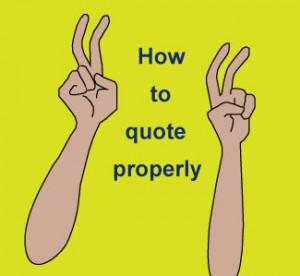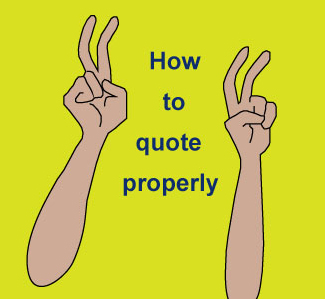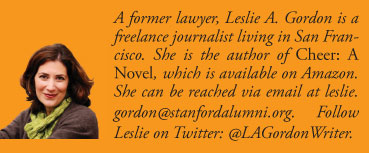 Quotation marks set off quoted or spoken language. Here are some usage guidelines:
Quotation marks set off quoted or spoken language. Here are some usage guidelines:
Periods and commas go inside quotation marks, including single quotation marks.
She said, “Bill said, ‘I don’t think we should see each other anymore.’”
Colons, semicolons and dashes remain outside quotation marks.
Mary described the game as “a real grudge match”: the players were ruthless.
If a question is part of the quotation, the question mark should be placed inside the quotation mark; otherwise, it stays outside.
He asked, “Will you marry me?”
Did you hear her say, “No, I won’t”?
Who said, “Absence makes the heart grow fonder”?
I love that song, “How Do I Live Without You?”
Use only one punctuation mark. If several apply, pick the stronger one. Exclamation marks are stronger than question marks.
Wasn’t it Paul Revere who said, “The British are coming!”
Use quotation marks for direction quotes only – when the language is particularly powerful or needs to be precise. In contrast, indirect quotations summarize or report what someone said.
She asked when you’d arrive.
Capitalize the first letter of a direct quote when the quoted material is a complete sentence but not when the material is a sentence fragment.
The judge said gay marriage was the “civil rights cause” of the modern day.
If the quotation is long, don’t use quotation marks; rather, set it out as an indented quote. Remember, though, that quotations are most effective when they’re short and used sparingly.
If you need to quote something with an error, use sic.
Her letter said, “If you’d like to marry me, than [sic] get a job first.”
Quotation marks can signal irony or sarcasm.
My boyfriend’s Chevy “accidentally” ran out of gas.
Finally, one of the most common proofreading errors I see is an open quotation mark without its closing partner.
About the author:




0 comments on “Legal Writing Tip: Usage Guideline for Quotations”